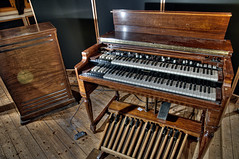While the Hammond organ was originally sold to churches as a lower-cost alternative to the wind-driven pipe organ, in the 1960s and 1970s it became a standard keyboard instrument for jazz, blues, rock, church and gospel music.
The original Hammond organ used additive synthesis of waveforms from harmonic series made by mechanical tonewheels that rotate in front of electromagnetic pickups.
In the late 1960s and throughout the 1970s the distinctive sound of the B-3 organ (often played through a Leslie speaker) was widely used in blues, progressive rock bands and blues-rock groups.The Leslie speaker creates special audio effects using the Doppler effect by rotating the speakers or a sound-directing duct.
Named after its inventor, Donald Leslie, it is particularly associated with the Hammond organ, says Wikipedia, but is used with a variety of instruments as well as vocals.
Leslie originally bought a Hammond organ in 1937, in the hope it would be a suitable substitute for a pipe organ, but was disappointed with the sound in his home compared to the large showroom where he had originally heard it. Consequently, he attempted to design a speaker to overcome this. He initially tried making a cabinet similar to Hammond's own, but then surmised the variation in sound a pipe organ produced because of the different location of each pipe meant he should try making a moving speaker. He developed the familiar combination of a rotating drum and horn for bass and treble frequencies respectively.[1]
Subscribe to:
Post Comments (Atom)





No comments:
Post a Comment